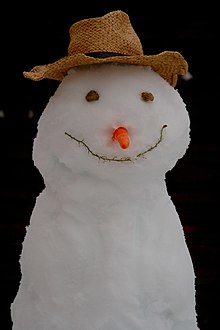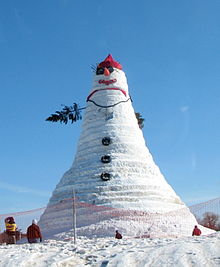Snowman

A snowman is an anthropomorphic snow sculpture. They are customarily built by children as part of a family project in celebration of winter. In some cases, participants in winter festivals will build large numbers of snowmen. Because a snowman is situation-specific, it is a good example of popular installation art.
Construction


Snow becomes suitable for packing when it approaches its melting point and becomes moist and compact. This allows for the construction of a large snowball by simply rolling it, until it grows to the desired size. If the snow ball reaches the bottom of the grass it may tear up some grass, gravel, dirt etc. Making a snowman out of powdered snow is difficult since it will not stick to itself, and if the temperature of packing snow drops, it will form an unusable denser form of powdered snow called crust. Thus the best time to build a snowman is usually in the next warmest afternoon directly following a snowfall with a sufficient amount of snow. In Europe and North America, snowmen are built with three spheres depicting the head, torso, and lower body.
The usual practice is to then dress the snowman, usually with rocks, coal, sticks, and vegetables. Carrots or cherries are often used for the nose, as are sticks for arms and stones for eyes (traditionally lumps of coal). Some like to dress their snowmen in clothing (scarves, jackets, hats). Others prefer not to risk leaving supplies out doors where they could easily be stolen or become stuck under melting ice. There are variations to these standard forms. These other types range from snow columns to elaborate snow sculptures (similar to ice sculptures).
Snowmen are usually built with two spheres in East Asia. In Japan, they are called yuki daruma (雪だるま, yuki daruma) after the round shape of the Daruma doll.
History
History failed to document the building of the first snowman. An urban legend had sprung up by April, 2004, claiming that the first snowman was built in 1809 by Vernon N. Paul and his 9 years old daughter, Yetty.[1] [dead link]
However, Bob Eckstein, author of The History of the Snowman documented snowmen from medieval times, by researching artistic depictions in European museums, art galleries, and libraries. The earliest documentation he found was a marginal illustration from a work titled Book of Hours from 1380, found in Koninklijke Bibliotheek, in The Hague[2]
In fiction
- Arktos in the German animated series Tabaluga.
- Bouli, a French animated series about a snowman's adventures in a magical place.
- in the game Mother there is a town called Snowman.
- Der Schneemann, a 1943 animated short film created in Germany.
- Jack Frost (1998 film), a movie with Michael Keaton in which he wakes up as a snowman after a car accident.
- Jack Frost (1996 film), a horror movie in which a serial killer is transformed into a snowman.
- Rave Master, a Japanese manga in which Plue, the hero's companion, resembles a small snowman.
- The Snowman, British picture book (1978) by Raymond Briggs and animation (1982) directed by Dianne Jackson about a boy who builds a snowman that comes alive and takes him to the North Pole.
- Frosty, the titular snowman in the popular children's song Frosty the Snowman, had a corncob pipe, a button nose, and two eyes made out of coal.
- Calvin and Hobbes, an American cartoon by Bill Watterson, contains many instances of Calvin building snowmen, many of which are deformed or otherwise abnormal, often used to poke fun at the art world.[3]
- Steven Millhauser, in one of his collections of short stories, called In the Penny Arcade wrote a short story called Snowmen in which children make snowmen which are more and more elaborate.
- In the platform game Caverns of Hammerfest, by the French developer Motion Twin, you control a snowman named Igor.
- Snow Bros, an arcade game released in 1990 featuring two snowball-throwing snowmen as the protagonists.
- Hans Christian Andersen wrote an winter fairy story, The Snowman.
- Jesus vs. Frosty depicts an evil version of Frosty the Snowman. This animated short was the beginning of the show South Park.
World's largest snowman

The record for the world's largest snowman was set in 2008 in Bethel, Maine. The snow-woman stood 122 feet 1 inch (37.21 m) in height, and was named in honor of Olympia Snowe, a U.S. Senator representing Maine.[4]
The previous record was also a snowman built in Bethel, Maine, in February 1999. The snowman was named "Angus, King of the Mountain" in honor of the then current governor of Maine, Angus King. It was 113 feet 7 inches (34.62 m) tall and weighed over 9,000,000 pounds (4,080,000 kg).[5]
Unicode
A snowman symbol is included in the Unicode character set with code point U+2603. (☃)
See also
References
- ^ "If you Like Shopping/The story behind the first snowman". Spring Flowers. 2004-04-02. Retrieved 2010-01-11.
- ^ Eckstein, Bob (2008-12-02). "My Search for The First Snowman". The History of the Snowman. Open Salon. Retrieved 2010-01-11.
- ^ Calvin and Hobbes Snow Art Gallery
- ^ 2008 World’s Tallest SnowWoman
- ^ "Angus, King of the Mountain — World's Largest Snowman". Sunday River On-Line. February 19, 1999. Archived from the original on 2007-10-12.
Further reading

- Bob Eckstein, The History of the Snowman: From the Ice Age to the Flea Market (2007)
- Scottie Davis, "Snow Day, A Photographic Journal of the Best Snowmen" (2004)
